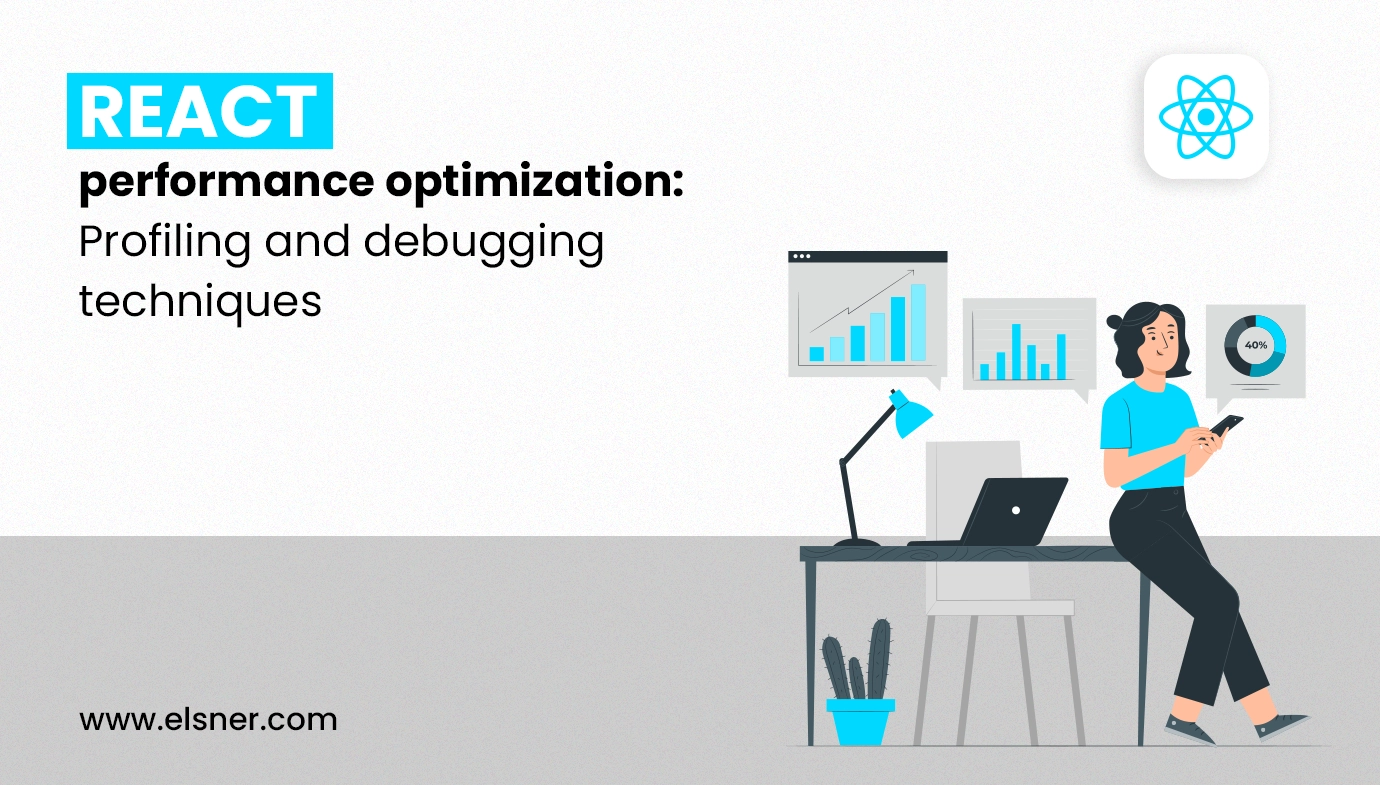- What are Some Tools & Techniques Used for React Performance Optimization?
- Performance Monitor:
- Debugger:
- Chrome DevTools:
- What are Some of the Performance Optimization Techniques for ReactJS Apps Using Profiling & Debugging?
- Keep the Component State as Local Wherever Necessary
- Memoizing React AppComponents to Avoid Unwanted Renders
- Implement React.memo( )
- Make Use of useMemo and useCallback Hooks
- Code Splitting for React through Dynamic import ( )
- Conclusion
High performance is one of the most crucial factors for any application, and the ReactJS developers pay immense attention to ensure it is obtained. Optimal performance with fast, efficient and responsive UI is what makes a React app provide better engagement. As per the research done by Portent, it is concluded that a site with a one-second loading speed has a higher conversion than a site with a ten-second loading speed. It is nothing new for ReactJS developers to focus on performance as their core aspect while developing apps.
When you choose the React framework for your applications, you are automatically guaranteed the best UI. But, if the integrations and coding works aren’t done right, you might experience performance hiccups when the app starts to grow in the long run.
So, profiling and debugging are among the few techniques that any professional React JS development company would recommend for you to optimise the performance of your app. To give you a better insight, this article will enlighten you on some of the associated strategies to revive the performance of your ReactJS apps.
What are Some Tools & Techniques Used for React Performance Optimization?
Performance profiling is the approach of using tools to identify specific areas of the app, which might be triggering performance issues. In the React Native environment, there are various profiling tools available for you to use for performance optimisation, which include:
-
Performance Monitor:
It is one of the built-in tools used for monitoring the app’s performance in real-time. This provides information on memory usage, CPU usage and FPS (frames per second).
-
Debugger:
Debugger is another popular tool that’s used for profiling and debugging React apps. It provides the app owners or
ReactJS developers with a comprehensive view of the application components, state and props.
Thus, it will be easier for the developers to detect the performance issues in a React app. For using this tool, you can hire dedicated ReactJS developers and let them install the React debugger on your local machine.
-
Chrome DevTools:
Chrome DevTools is yet another powerful tool for profiling web apps, which can also be used for profiling React applications. It provides you and developers with a holistic view of various app performance metrics, such as CPU usage, memory usage, etc.
What are Some of the Performance Optimization Techniques for ReactJS Apps Using Profiling & Debugging?
Some of the ReactJS performance optimisation techniques for the dedicated apps, with respect to profiling and debugging, include:
-
Keep the Component State as Local Wherever Necessary
As per the technical aspects, any state update within the parent component will re-render both parent as well as child components. Therefore, to ensure that your re-rendering needs for a component happen only when necessary, you must extract a specific part of the overall code related to the component state. Now, you must make that part of the code local to the overall state.
When you do this, be assured that the component which cares about the state will be the one that gets rendered. Within the code, only your input field cares about the component state. Therefore, it gets extracted and used as the input component, which acts as the sibling-to-child component.
It means that the component will re-render only when the state changes within the input component. Hire dedicated ReactJS developers to help you initiate the code changes and test run the same. This way, you will see that the child components will no longer be re-rendering for every keystroke you make. With such an implementation, you will be able to improve the React app performance immensely.
-
Memoizing React AppComponents to Avoid Unwanted Renders
Unlike refactoring the code that you did in the last strategy, this memoising approach is a time-saver yet memory-consumer alternative. Here, you will be memoising any component, only when it is necessary.
For you to better understand the concept, memoisation is a performance optimisation technique where the component-rendered operations are cached, and the results are saved in the memory. Now, the cached result gets returned for the exactly same input.
If the child component is receiving a prop, the memoised component will be the same by default. This will skip the re-rendering of the child component when the prop isn’t changed. You can make use of React.memo for all the functional components. The following code can be used for invoking memoisation:
const ExpensiveComponent = React.memo(({ prop1, prop2 }) => {
// …
});
-
Implement React.memo( )
For you to know, React.memo is considered one of the high-order components that wraps the purely functional components, which can prevent re-rendering if the props received within the component don’t change. import React, { useState } from “react”;
// …
const ChildComponent = React.memo(function ChildComponent({ count }) {
console.log(“child component is rendering”);
return (
<div>
<h2>This is a child component.</h2>
<h4>Count: {count}</h4>
</div>
);
});You can
hire ReactJS developers to invoke this code in your app and ensure your React.memo( ) is invoked. This code specifies if the count prop doesn’t change, React will be skipping the need for rendering your child component, and will be reusing the previously rendered results. Thus, it will scale the performance of React apps immensely.
React..memo( ) tends to work with utmost efficiency when primitive values are passed with it, such as numbers. The primitive values are meant to be referentally equal and will return true if the importance doesn’t change. On the other end, any non-primitive matter which consists of functions or arrays, will always return false between the re-renders, as they will be pointing to different memory spaces.
-
Make Use of useMemo and useCallback Hooks
The useCallback hook in React is considered one of the powerful approaches for improving the performance of your apps. It prevents unnecessary renders and enables you to memoise functions and make sure that a unified function object is used across diverse renders. You will be able to render the child components selectively within the parent component. Using the dedicated command, you will be creating memoised functions and passing them as specific props to the child components.
const memoizedCallback = useCallback(() => {
// Function definition
}, [dependency1, dependency2]);
If the prop that you are passing down to the child component is an object or array, you will be able to integrate the useMemo hook for memoising the value between those renders. You also have the liberty to incorporate the useMemo hook to avoid any re-computing process for the same component value. You will be able to memoise the values and implement re-computation only if the dependencies are subject to change.
Just like useCallback, the useMemo hook also expects a specific function and a complete array of dependencies, which include:
const expensiveValue = useMemo(() => {
// Expensive computation
}, [dependency1, dependency2]);
Using the command, you will be able to memoise the return value of the expensiveValue, ensuring it just re-computes the functions when there is a need for it.
-
Code Splitting for React through Dynamic import ( )
If you are about to hire ReactJS developers to optimise your app performance, code splitting is one of the most crucial tasks that they will try to integrate. As per the default actions are concerned, when the React app renders within the browser, the bundle file with the entire app code will load and serve the content to the users in no time.
This file is generated by merging all the code files that are needed to make the web app work. The idea of bundling is immensely useful as it will reduce the count of HTTP requests that a specific page can easily handle. But, as the app grows, the size of the file will also increase which will further scale the size of your bundle file as well. Thus, at one point, the bundle file will slow down the initial page loading speed, which will hamper the user satisfaction quotient.
With the use of the code splitting technique, the ReactJS developers split the large bundle files into different parts by using the dynamic import ( ) command, followed by lazy loading of those parts with the use of React.lazy. Such a strategy will improve the performance of even a complex React app.
For implementing code splitting, the developers will be transforming a usual React import as:
import Home from “./components/Home”;
Import About from “./components/About”;
Following that, the code will then be imported with the lazy loading attributes, which demands developers to implement code as:
const Home = React.lazy ( ( ) => import (“./components/Home”));
const About + React.lazy ( ( ) +> import (“./components/About”));
This syntax indicates React for loading every component dynamically. Thus, every time the user follows a specific link to the homepage, React will only download the file for a requested page instead of loading a big-sized bundle file for an entire app. After the import process is done, developers must render all the lazy components.
Conclusion
These are the five most crucial strategies that will help you with profiling and debugging your React app. You will be able to prevent unwanted renderings, which will turn around for enhancing your core app performance. Hire a professional React JS development company and let them leverage the potential of the right profiling and debugging tools to integrate performance optimisation techniques for your app.
The experts will not just be tracking the performance of your React app through dedicated metrics but will also suggest ideal measures to improve the specific attributes.

About Author
Pankaj Sakariya - Delivery Manager
Pankaj is a results-driven professional with a track record of successfully managing high-impact projects. His ability to balance client expectations with operational excellence makes him an invaluable asset. Pankaj is committed to ensuring smooth delivery and exceeding client expectations, with a strong focus on quality and team collaboration.




